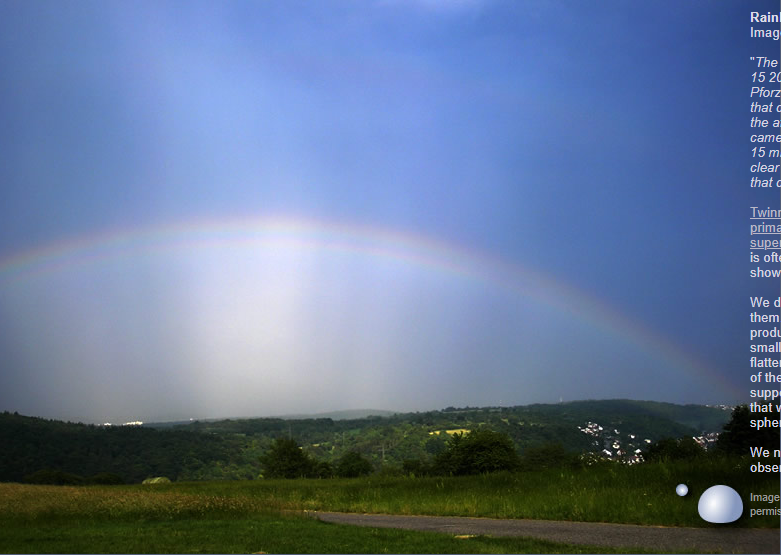Mystery Twinned Rainbow
The Mystery of the Twinned Rainbow: Exploring an Enigmatic Atmospheric Phenomenon
Rainbows have captivated and fascinated humans for centuries, but there are some rare and elusive variations that continue to puzzle scientists and observers alike. One such intriguing phenomenon is the twinned rainbow. Unlike the more commonly seen single rainbow, the twinned rainbow appears as two distinct bows side by side. In this article, we delve into the mystery of the twinned rainbow, exploring its characteristics, possible causes, and the need for further research.
Unraveling the Enigma
One notable sighting of a twinned rainbow occurred on June 15, 2006, in Bilfingen, northwest of Pforzheim, Germany. The day began with clear and warm weather, but in the afternoon, a fresh stormy wind blew in, accompanied by a short shower. Remarkably, within 15 minutes, the weather cleared up again, and it was during this fleeting period that the twinned rainbow graced the sky. Interestingly, this particular shower was the only one experienced that day.
Distinguishing Twinned Bows
It is essential to differentiate between a twinned bow and a supernumerary fringe, as they are often confused. While supernumerary fringes appear as faint additional bands of color within a primary rainbow, twinned bows manifest as distinct, separate arcs. These twin bows are typically associated with intense showers and have a relatively short duration, further adding to their mystique.
Unveiling Possible Explanations
The precise cause of twinned rainbows remains uncertain, leaving scientists with several theories to explore. One hypothesis proposes that the twinning arises from two different types of raindrops: small spherical ones and large flattened ones. The secondary bow's lack of splitting provides some support for this idea. Another theory suggests that water droplets containing ice spheres may be responsible for creating the twinned bows. However, more research and observations are needed to validate these hypotheses.
The Importance of Photographs and Observations
To unravel the secrets of the twinned rainbow, researchers heavily rely on photographs and observations from keen observers. These visual records allow scientists to study the phenomenon in detail, analyze its characteristics, and compare different instances of twinned rainbows. By gathering a comprehensive dataset, researchers can better understand the underlying mechanisms and potentially identify patterns or factors that contribute to the occurrence of twinned rainbows.
The Role of Atmospheric Optics Enthusiasts
Atmospheric optics enthusiasts play a crucial role in expanding our knowledge of rare phenomena like the twinned rainbow. By actively observing and documenting their sightings, these enthusiasts contribute valuable data to scientific investigations. Their photographs, detailed descriptions, and even sketches help researchers build a more comprehensive understanding of the conditions under which twinned rainbows form and the variations in their appearance.
The Quest for Answers Continues
While progress has been made in studying twinned rainbows, many questions remain unanswered. The rarity and ephemeral nature of these optical marvels make them challenging to capture and study comprehensively. Consequently, ongoing research efforts aim to gather more data, expand the available observations, and refine existing theories. By deepening our understanding of the twinned rainbow, we can gain further insights into the complex interplay of light, water droplets, and atmospheric conditions.
Conclusion
The mystery of the twinned rainbow continues to intrigue scientists and observers alike. This rare atmospheric phenomenon offers a glimpse into the complexities of light refraction, raindrop characteristics, and weather patterns. While theories exist regarding the causes of twinned rainbows, further research, extensive observations, and a robust dataset are essential to unraveling this enigma fully. By collaborating with atmospheric optics enthusiasts and leveraging advancements in technology, scientists hope to shed more light on the captivating world of twinned rainbows and bring us closer to understanding their secrets.

Rainbow Mystery
Imaged by Michael Großmann.
"The twinned bow was seen June 15 2006 at Bilfingen, northwest of Pforzheim, Germany. The weather that day started clear and warm. In the afternoon a fresh stormy wind came up with a short shower. After 15 minutes the weather became clear again. It was the only shower that day"
Twinned bows are a doubling of the primary - not to be confused with a supernumerary fringe. The twinning is often associated with violent showers and only lasts a short time.
We don't know for sure what causes them. The two bows might be produced by two types of raindrop, small spherical ones and large flattened ones. The lack of splitting of the secondary bow give some support to this. Another theory is that water drops containing ice spheres make the bows.
We need more photographs and observations.
Image ©Michael Gro�mann, shown with permission.
Note: this article has been automatically converted from the old site and may not appear as intended. You can find the original article here.
Reference Atmospheric Optics
If you use any of the definitions, information, or data presented on Atmospheric Optics, please copy the link or reference below to properly credit us as the reference source. Thank you!
-
<a href="https://atoptics.co.uk/blog/mystery-twinned-rainbow/">Mystery Twinned Rainbow </a>
-
"Mystery Twinned Rainbow ". Atmospheric Optics. Accessed on April 16, 2024. https://atoptics.co.uk/blog/mystery-twinned-rainbow/.
-
"Mystery Twinned Rainbow ". Atmospheric Optics, https://atoptics.co.uk/blog/mystery-twinned-rainbow/. Accessed 16 April, 2024
-
Mystery Twinned Rainbow . Atmospheric Optics. Retrieved from https://atoptics.co.uk/blog/mystery-twinned-rainbow/.